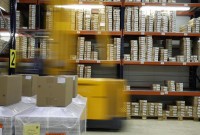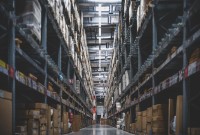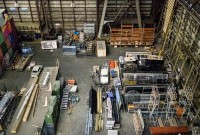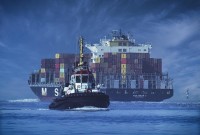- Home
- Business Processes
- Industry Knowledge
- Aerospace Industry
- Automotive Industry
- Banking Domain
- BFSI Industry
- Consumer/ FMCG Industry
- Chemicals Industry
- Engineering & Construction
- Energy Industry
- Education Domain
- Finance Domain
- Hospitality Domain
- Healthcare Industry
- Insurance Domain
- Retail Industry
- Travel and Tourism Domain
- Telecom Industry
- Leadership Skills
- eLearning
- Home
- Business Processes
- Warehouse Management
- Warehouse Labeling Process
Warehouse Labeling Process
Warehouses can be places where piles of packed or loose products occupy space. If left disorganized, it will become very challenging to identify products for packing or picking. Hence, proper organization of warehouse is very important. Warehouse labeling systems eliminate this problem by making sure products are easily identified and managed during the warehousing and shipping process. Labeling is the most functional and cost-effective way to keep your warehouse organized and operating efficiently.
What are warehouse labels?
Labels are printed slips that are affixed to warehouse goods for identification or description. Important information about the package or the item is prominently displayed on the label. Label is the written or printed matter accompanying an article to furnish identification or other information.
Why we need labeling system in place?
Warehouses can be places where piles of packed or loose products occupy space. If left disorganized, it will become very challenging to identify products for packing or picking. Hence, proper organization of warehouse is very important. Warehouse labeling systems eliminate this problem by making sure products are easily identified and managed during the warehousing and shipping process. Labeling is the most functional and cost-effective way to keep your warehouse organized and operating efficiently.
Here are some of the advantages of warehouse labeling.
• Warehouse labels eliminate mistakes.
• Ensures customers only receive the item they ordered.
• Provide warnings for items that should be treated with care.
• Capture several data elements like expiration dates, security or caution notes.
• Eliminated the confusion around location of items.
• Improve the efficiency and productivity of employees.
• Prevent supply chain issues such as backorders or incorrect shipments.
Types of Warehouse Labels
Depending on your business’s warehousing needs, there are several types of warehouse labels to choose from. Each of these items can be used together to streamline warehouse organization and make sure workers can easily identify every section, rack, and carton. Most warehouse labels are easy to install, which makes the labelling process quick and efficient. Availability of variety of label options can address the unique needs of manufacturing and warehousing companies.
Given below are some of the most common types labels:
Floor Labels
Floor labels are ideal for large warehouses with several rooms. They are manufactured to survive heavy floor traffic and wear and tear. They are designed to withstand harsh solvent, oil, hydrocarbon solutions, and other contaminants, and they can be customized for any size, shape, length, or content requirements.
Rack Labels
The most common type of warehouse label is a rack label, which is used to streamline workflow by making items and sections easier to identify for employees. They help identify the right products for inventory management, storing, and shipping purposes. There are several types of rack labels, and they include multi-level, magnetic, cold storage, and more. Rack labels can be easily color-coded for identification; they can also be designed with arrows, and can be placed on aisles for easy locating of items.
Warehouse Magnets
Out of all the warehouse label options, magnets are the most reusable option. They can be applied regardless of temperature, removed without any mess or scratches, and can be reapplied without the need of sticky adhesives like tape. Magnetic signs and labels are typically used for shelf and rack location labeling as they can be moved when required.
Retro-Reflective Labels
This option is used for barcoding shelves. They can be scanned up to 45 feet away due to use of light reflecting elements in the label. They are a great solution for warehouse racks, pallets, and other industrial surfaces.
Warehouse Signs
Warehouse signs can help identify hazards to employees working in the plant. Since most warehouse workers operate heavy machinery and have to navigate around sharp corners and aisles, warehouse signs are extremely important. Employees should be made aware of proper procedures and potential hazards within the warehouse, and these safety signs are helpful for notifying workers of forklift safety warnings, clearance height and capacity alerts, quality-control warnings, and safety reminders.
Related Links
You May Also Like
-
Business Case of Multiple Warehouses
Adding extra warehouses to business provides many benefits such as reducing shipping costs, increasing storage capacity, and having warehouses for specific purposes to simplify overall warehouse management. Multiple warehouses allow you to organize your inventory in a way that helps your business be more effective.
-
Before shipping, businesses need to make sure that the items will arrive in good condition. Packaging is a form of protection against environmental threats that the product will face from the time it leaves warehouse facility until the time it reached the customer. The packaging is intended to provide protection for the item as it is being handled in the warehouse or when the item is being shipped.
-
Inventory is money, and hence businesses need to perform physical inventory counts periodically to make sure that their inventory records are accurate. The traditional approach to conducting inventory counts is to shut down a facility during a slow time of year to count everything, one item at a time. This process is slow, expensive, and (unfortunately) not very accurate.
-
Miscellaneous Warehouse Processes
At the end of each inventory control, the Contractor provides the Ordering Person with an inventory report which contains a list of all stock adjustments. The Ordering Person uses the report to create, by use of his/her own means, necessary value and accounting adjustments related to the stock. Let us look at some to the mislaneous warehouse processes not covered earlier.
-
What is a Warehouse & why companies need them?
All organizations hold stocks. In virtually every supply chain, gaps exist between when something is produced and when a customer is ready to buy or receive it. Stocks occur at any point in the supply chain where the flow of materials is interrupted. This implies that products need to be stored during this period of gap.
-
One of the most important decisions when running a warehouse is its layout. Warehouse layout defines the physical arrangement of storage racks, loading and unloading areas, equipment and other facility areas in the warehouse. A good layout aligned with the business needs could have a significant effect on the efficiency.
-
The Outbound process starts with routing the shipments. The Outbound execution process starts from the point when pick tasks are completed for an outbound shipment and ends at the point where the outbound packages are loaded into trailers. The Warehouse Outbound process includes managing and controlling outgoing materials starting from the download of orders through to the shipping of products from the warehouse.
-
Types of Inventory Count Processes
While dealing with lots of inventory in a warehouse, lots of things can go wrong. Shipments may not have the right number of units in them, or they could get damaged somewhere along the supply chain. Discrepancies in the stock may arise as part of every inventory control, and need to be corrected immediately after the inventory control procedure has been finished.
-
Warehouses can be places where piles of packed or loose products occupy space. If left disorganized, it will become very challenging to identify products for packing or picking. Hence, proper organization of warehouse is very important. Warehouse labeling systems eliminate this problem by making sure products are easily identified and managed during the warehousing and shipping process. Labeling is the most functional and cost-effective way to keep your warehouse organized and operating efficiently.
-
At a high level, the essential elements in a warehouse are an arrival bay, a storage area, a departure bay, a material handling system and an information management system. As part of the process for enabling a warehouse layout, you must define warehouse zone groups, and zones, location types, and locations.
Explore Our Free Training Articles or
Sign Up to Start With Our eLearning Courses

About Us
Learning
© 2023 TechnoFunc, All Rights Reserved









